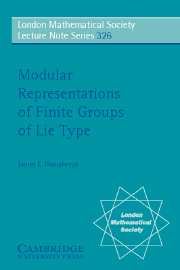Book contents
- Frontmatter
- Contents
- Preface
- 1 Finite Groups of Lie Type
- 2 Simple Modules
- 3 Weyl Modules and Lusztig's Conjecture
- 4 Computation of Weight Multiplicities
- 5 Other Aspects of Simple Modules
- 6 Tensor Products
- 7 BN-Pairs and Induced Modules
- 8 Blocks
- 9 Projective Modules
- 10 Comparison with Frobenius Kernels
- 11 Cartan Invariants
- 12 Extensions of Simple Modules
- 13 Loewy Series
- 14 Cohomology
- 15 Complexity and Support Varieties
- 16 Ordinary and Modular Representations
- 17 Deligne–Lusztig Characters
- 18 The Groups G2(q)
- 19 General and Special Linear Groups
- 20 Suzuki and Ree Groups
- Bibliography
- Frequently Used Symbols
- Index
5 - Other Aspects of Simple Modules
Published online by Cambridge University Press: 23 November 2009
- Frontmatter
- Contents
- Preface
- 1 Finite Groups of Lie Type
- 2 Simple Modules
- 3 Weyl Modules and Lusztig's Conjecture
- 4 Computation of Weight Multiplicities
- 5 Other Aspects of Simple Modules
- 6 Tensor Products
- 7 BN-Pairs and Induced Modules
- 8 Blocks
- 9 Projective Modules
- 10 Comparison with Frobenius Kernels
- 11 Cartan Invariants
- 12 Extensions of Simple Modules
- 13 Loewy Series
- 14 Cohomology
- 15 Complexity and Support Varieties
- 16 Ordinary and Modular Representations
- 17 Deligne–Lusztig Characters
- 18 The Groups G2(q)
- 19 General and Special Linear Groups
- 20 Suzuki and Ree Groups
- Bibliography
- Frequently Used Symbols
- Index
Summary
So far we have focused attention mainly on the classification and description of simple modules for a group of Lie type. This chapter assembles a number of more-or-less independent topics which emerge naturally from this study:
In 5.1 we look at how Frobenius maps permute simple G-modules of arbitrary highest weight. This contributes in turn to a determination of minimal splitting fields (5.2).
When there are two root lengths, with p equal to the squared ratio of long to short, special isogenies exist between algebraic groups with corresponding dual root systems. This leads to a refined tensor product factorization of their simple modules. For the nonisomorphic groups of types Bℓ and Cℓ with ℓ > 2 in characteristic 2, we then find a dimension-preserving bijection between the two collections of simple modules (5.3–5.4).
After recalling some standard facts about Grothendieck rings and Brauer characters (5.5), we compare formal characters for G-modules with Brauer characters for GF (5.6).
Several sections explore a recurring theme: the behavior of G-modules on restriction to a finite group of Lie type. Examples include simple modules L(λ) for arbitrary λ ∈ X+, tensor products of simple modules, Weyl modules. Further instances will arise later in the study of projective modules, Ext groups, etc.
When dealing with an arbitrary KG-module M we use the notation [M : L]G for the number of composition factors of M isomorphic to a given simple module L, and similarly with G replaced by the algebraic group G.
- Type
- Chapter
- Information
- Modular Representations of Finite Groups of Lie Type , pp. 41 - 52Publisher: Cambridge University PressPrint publication year: 2005



